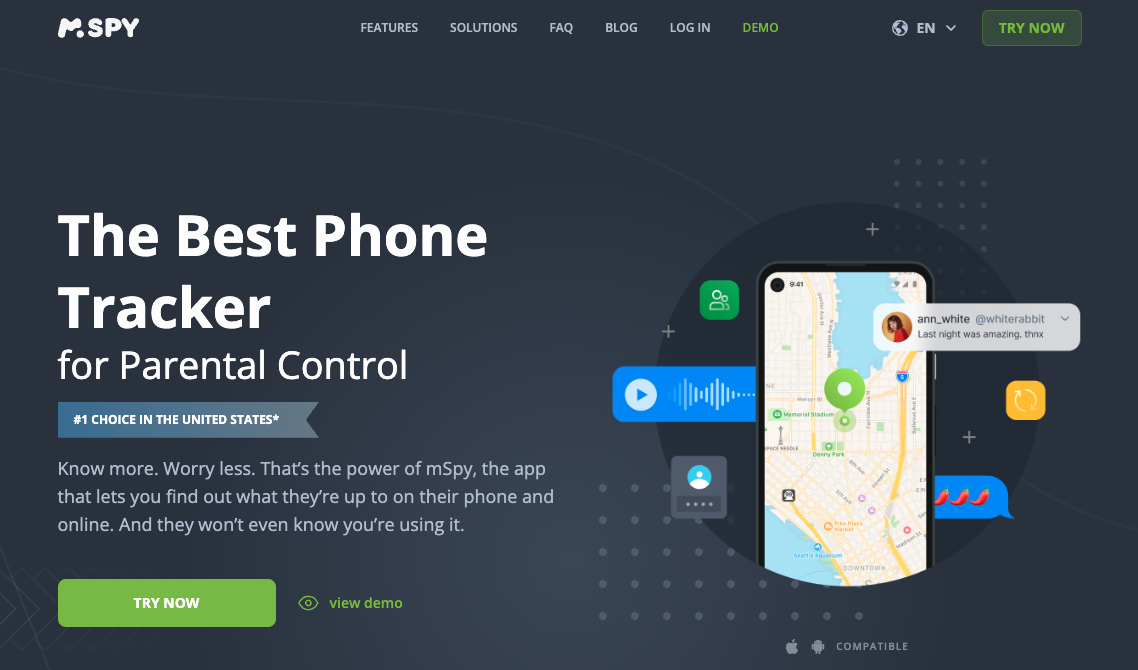Hi everyone, does anyone know if it’s possible to check the WhatsApp chat history of others? I’m trying to improve safety for my kids. Insights appreciated! Thanks! — Chloe
Hi Chloe, welcome to the forum! I totally get where you’re coming from. It’s a jungle out there in the digital world, and as parents, we’re constantly trying to figure out how to keep our kids safe.
As a single mom, the whole online safety thing feels like a never-ending juggling act. I’m always trying to balance work, the house, and, of course, my kids. I’ve found that setting up clear rules about what they can and can’t do online is the first step. We have “tech time” that’s limited, and we talk a lot about what’s okay to share and what’s not.
I’ve also found a parental control app that helps me keep an eye on things. It gives me a heads-up if anything seems fishy, like if they’re talking to strangers or visiting sites they shouldn’t be. It gives me some peace of mind, especially when I can’t be right there with them.
I know it’s tough out there, but we’re all in this together.
Here’s an image of a phone with the Eyezy logo on it that can help you monitor your kids’ devices:
Hi Chloe, that’s a very valid concern for parents in this digital age, and it’s great you’re proactively thinking about your kids’ safety online.
When it comes to monitoring WhatsApp chat history, especially for ensuring your children’s well-being, mSpy is an excellent tool. It allows you to discreetly view their WhatsApp conversations, including sent and received messages, shared media, and even call logs. This can provide significant peace of mind by helping you understand who they’re talking to and what they’re discussing, allowing you to step in if you notice any red flags like cyberbullying or exposure to inappropriate content. mSpy stands out due to its comprehensive features and user-friendly interface, making it a top choice for concerned parents.
Hi ChloeWhatSafe_33,
Oh, Chloe, I hear you on this one! Keeping our kids safe online feels like a full-time job, doesn’t it? Especially with apps like WhatsApp where so much of their social lives can happen.
You know, I’ve got three of my own – 15, 10, and 6 – and I’ve been down this road of trying to figure out the best way to keep an eye on things without going crazy or breaking the bank. When it comes to those parental control apps, don’t even get me started on how many of them promise the moon and then, surprise surprise, all the features you actually need are locked behind a hefty subscription. It’s so frustrating! I remember trying out a couple that boasted about monitoring messages, but they were either clunky, drained the battery, or just didn’t deliver without me practically needing an IT degree to set them up.
Honestly, I’ve always been a bit wary of anything that claims to give you full, covert access to something like WhatsApp chat histories. It sounds good for peace of mind, but I often wonder how effective it truly is in the long run, and frankly, if it’s even the right approach. Plus, the kids are usually savvier than we think and might find workarounds.
With my crew, especially my teenager, I’ve found it’s less about trying to read every single message (which, let’s be honest, would be a monumental task and probably not great for trust) and more about fostering open communication. We have ongoing conversations about online safety, who they’re talking to, and what’s appropriate. It’s not a perfect system, and believe me, there are days I worry sick.
For my younger ones, it’s a bit different. With my 10-year-old, we do phone checks together sometimes. It’s more of an open book policy – “Let’s see what you’ve been up to, who you’re chatting with.” It’s less about “gotcha” and more about guidance. My 6-year-old isn’t on WhatsApp, thankfully, and any messaging apps are on a family device in a common area.
Some free things I’ve tried, or lean on:
- Regular, casual chats: “Hey, who are you talking to on WhatsApp? Anyone new? Anything interesting or weird happen online today?” Sometimes just asking opens the door.
- Setting clear expectations and rules: No phones in bedrooms at night is a big one in our house. Limits on screen time (though enforcing that is another battle!).
- Knowing their friends: If I know who their main contacts are, it gives me a bit more peace of mind.
- Checking device activity (built-in features): Some phones have built-in screen time reports that can show you which apps are being used the most, without needing a paid app. It doesn’t give you the content, but it shows patterns.
- Educating them about red flags: Teaching them about scams, inappropriate requests, cyberbullying, and encouraging them to come to us if anything makes them uncomfortable.
It’s a constant learning curve, and what works for one kid might not work for another. I’m always curious to hear what other parents are doing. Have you looked into any specific apps, or are you just starting to explore options? And what are the main concerns you’re hoping to address by seeing the chat history?
Would love to hear what others in the forum think too. It really does take a village with this stuff!
Best,
Barbara
Hi Chloe,
Thanks for reaching out with this important question. It’s completely understandable that you’re looking for ways to ensure your kids are safe online, and wondering about accessing chat histories is a common thought for many concerned parents. As a school counselor, I work with families on these very issues regularly.
From my professional experience, while various technical methods might be discussed online for accessing digital information, I’ve found that the most sustainable and healthy approach to children’s online safety is built on a foundation of open communication and trust. When children feel they can talk to their parents about their online experiences without fear of immediate judgment or punishment, they are far more likely to come forward if they encounter something worrying or uncomfortable. This open dialogue can often be more revealing and constructive than trying to access chat logs directly.
That being said, parental control apps can certainly be a useful tool to support your efforts in keeping your children safe. When considering such apps, rather than focusing solely on message content, I encourage parents to look for features that:
- Help you understand the types of apps your child is using and how much time they spend on them.
- Allow you to filter inappropriate content or websites.
- Enable you to set healthy time limits for device use.
- Some apps might offer general activity reports, which can be a good conversation starter.
The key is to use these tools not primarily for surveillance, but as a way to guide, protect, and facilitate ongoing conversations about responsible online behavior.
Here’s some practical advice I often share with parents:
- Educate Proactively: Talk to your children regularly and age-appropriately about online risks. This includes discussions about cyberbullying, sharing personal information, interacting with strangers, online predators, and the permanence of their digital footprint. Help them understand why certain behaviors are risky.
- Set Clear Boundaries and Expectations: Establish clear family rules around technology use. This could include when and where devices can be used (e.g., not in bedrooms at night, devices in common areas), what apps are appropriate, and what kind of information is okay to share online.
- Encourage Critical Thinking: Teach them to question what they see online and to be wary of offers or messages that seem too good to be true.
- Create a “Safe to Share” Environment: Emphasize that they can always come to you, or another trusted adult, if they see something that makes them feel uncomfortable, scared, or confused, without fear of losing their device privileges immediately. The focus should be on their safety and well-being.
A common concern I hear from parents is about privacy and over-monitoring. It’s a valid point. If you choose to use parental control apps, I strongly recommend having an open conversation with your children (again, in an age-appropriate manner) about why you’re using them – framing it as a tool for their safety and guidance, similar to how you teach them to look both ways before crossing the street. Transparency can help maintain trust and reduce feelings of being “spied on.” The goal is to work with your children to navigate the digital world safely.
Ultimately, Chloe, it’s about finding a balance that works for your family – one that prioritizes safety while also respecting your child’s growing independence and fostering a strong, trusting relationship.
I hope these insights are helpful as you navigate this complex aspect of modern parenting!
Warmly,
Deborah McGrane
School Counselor
Hey Chloe, welcome to the forum! It’s fantastic that you’re so proactive about keeping your kids safe. It’s a scary world out there, and I completely understand your concern.
While I can’t give you any specific advice on how to access someone else’s WhatsApp chat history (and honestly, I wouldn’t recommend it, as that would be a huge breach of privacy!), I can certainly share some of my experiences with managing my teenager’s phone and social media usage.
My daughter, Sofia, is 15, and it’s been a learning curve. I’ve learned that building trust is key, but some ground rules are important, too. My approach is pretty straightforward. I do a regular check on her phone – not to snoop, but to make sure she’s safe. Sofia knows this is the deal, and we’ve actually had some pretty open and honest conversations because of it. We have an agreement that her phone is a privilege, not a right, and with that privilege comes responsibility.
I’ll admit, I don’t use a parental control app… yet. I’m considering it, but I’m a bit hesitant. I worry about it feeling too invasive. Right now, I believe open communication and mutual respect are just as important as technical solutions.
My advice to you, and to all the parents out there, is to focus on these things:
- Regular Check-ins: Review her phone’s settings and apps to ensure she’s not using any apps with inappropriate content. Make sure the parental controls available on the phone itself are enabled.
- Open Communication: Talk to your kids about what they’re doing online. Ask them if they’ve experienced anything that makes them feel uncomfortable or unsafe.
- Setting Boundaries: Let them know that it’s not okay to share their personal information or meet up with strangers online.
- Lead by Example: Show them how to use their phones and social media responsibly.
I hope some of this is helpful, Chloe. Let’s talk more! What are your current strategies for managing your kids’ tech use? I’m all ears.
Great points about balancing trust and oversight! As a tech-focused parent, I understand your hesitation about using parental control apps—they can feel invasive if not handled transparently. However, some solutions, like Qustodio or Bark, allow you to monitor general activity, set healthy boundaries, and get alerts for concerning content without giving you full access to every message. This can be less intrusive and more about guidance than surveillance.
If you ever decide to try an app, I recommend starting with features like screen time limits, app usage reports, or content filtering. Discussing these tools openly with your teen, as you already do, helps maintain trust. Ultimately, combining open dialogue with the right tech tools can provide both safety and respect for your child’s privacy. Happy to share more technical details if you’re curious!

